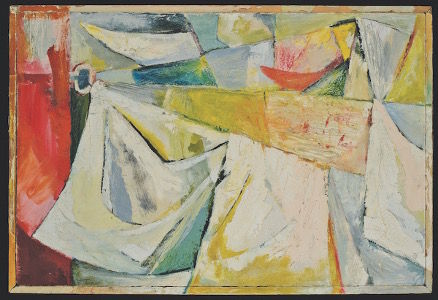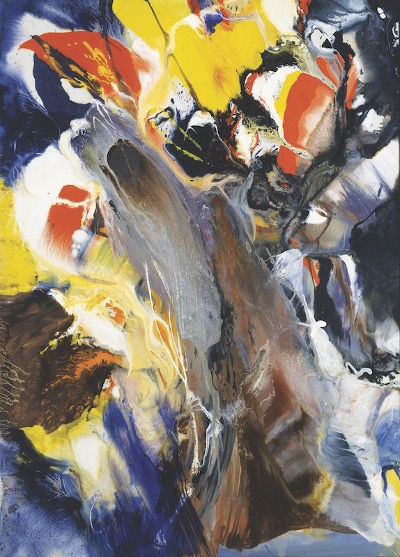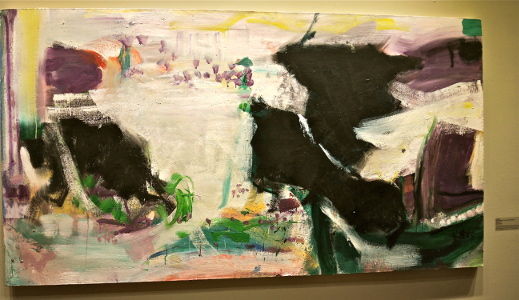CURATOR'S CHOICE SM
Exhibition Reviews
| Home | | Museum
Guide | | International |
| Theater |
Julia Slaff
| “On the Front Lines: Military Veterans at The Art Students League of New York” (June 19 - July 29, 2015) The Art Students League of New York is a classroom for professional and aspiring artists to explore art in a beautiful and historic setting. Great American artists such as Edward Hopper and Jackson Pollock have graced the studios of this fine arts society. This summer, from June 19 to July 29, 2015, the Phyllis Harriman Mason Gallery, lobby, main office and cafe are showing “On the Front Lines: Military Veterans at The Art Students League.” The exhibition is a unique evaluation on the GI Bill’s impact upon American art following World War II. Jillian Russo, Curator for The Art Students League of New York, writes in the show’s informational guide that the effect of the GI Bill on American art is hardly discussed. She explains that the impact of the Servicemen’s Readjustment Act, or the G.I. Bill, laid the foundation for much of the artistic exploration of the postwar period. The Bill offered war veterans 500 dollars per year, along with a monthly living stipend, giving thousands of veterans the financial backing for full-time artistic study. The main gallery space explores the historical impact on the veterans sponsored by the GI Bill, while the associated areas house a juried exhibition of contemporary art by veterans who are current or former students of the League. The Phyllis Harriman Mason Gallery is a white-walled and wood-grain floored, intimate gallery space. Twenty works line the gallery walls and pedestals, varying in media from oil paint to bronze sculpture. There is no singular artistic theme or movement running through the exhibit; abstraction and representational works blend together with one another creating an array of well-rendered works.
From the 1940s to the 1950s, artists from Al Held to Robert Rauschenberg started their careers at the League. Many students following World War II became movers and shakers within the movement of Abstract Expressionism, such as Stanley Boxer, Michael Goldberg, Alfred Leslie, Al Held, John Hultberg and Robert Rauschenberg. All have paintings on display. These artists explored abstraction and different uses of paint. A prime example of exploration of Abstract Expressionism is seen in Leslie’s watercolor from his 1953 to 1954 series titled “Hoboken Baby.” During Leslie’s time at the League, he was a part of the “9th Street Exhibition” alongside famous New York School painters Willem de Kooning and Jackson Pollock in 1951.
Rauschenberg’s exploration of this new movement at the Art Students League is seen in his painting “Wash,” done during his time working with Morris Kantor from 1949 to 1951, in which he breaks solid forms into overlapping color fields and utilizes collage. Evidence of Kantor's students exploring Abstract Expressionism’s tendency towards combining abstracted forms and color fields with representational facets are seen in Boxer’s “Figure in an Interior” and Hultberg’s “The Tower.” Painterly approaches to Abstract Expressionism are clearly developed in Paul Jenkin’s 1959 large canvas “Phenomena of Air Striae.” It is an inky painting that undulates with drippy layers of enamel and paint. Jenkin’s application of the paint is a paradox for the eyes: the liquid binder he used mixes subdued grays and bright colors, making a calm flow and yet, a bold composition.
Contemporary paintings bouncing off Abstraction Expressionism by veterans-turned-artists William Scharf and Frank O’Cain came out of the League, alongside a tradition of realism and portraiture by Daniel Greene and Everett Raymond Kinstler. Instructor Hughie Lee-Smith worked on a style fusing surrealism, realism and abstraction, particularly seen in his 1986 piece “Abandoned.” Lee-Smith during World War II, was employed by the WPA Federal Art Project and for the US Navy painted a historical mural. He emerged in the art world for similar desolate industrial and urban scapes.
The GI Bill, the piece of government legislation unifying these works, launched the journeys of these artists in a plethora of directions. It made students into teachers, formed collaborations such as Robert Rauschenberg and Cy Twombly, enabled material exploration for innovators such as Jenkins, furthered education of talents like Al Held and gave expositions to the likes of Peter Golfinopoulos. Veteran Stanley Boxer, in 1985, credited the G.I. Bill for his own artistic endeavors. He wrote that a country once lacking in culture was saved by this legislation and that the finest art, literature, science and music in the decades following it were American.
Boxer felt that this same milieu also sparked social movements - he considered it the energizer of the Civil Rights movement. The fight for racial equality affected students of the Art Students League along with scars from the wars. African-American painter Charles Alston, who became a member of the faculty in 1951, responded to the Civil Rights movement with a series of paintings, including “Red, White and Black,” on display in the show. While dealing with the issues of being black in America, the painting also recalls the GI Bill’s limitations. “On the Front Lines” importantly notes that the promises of the ‘American Dream’ of an education and a suburban home with a white-picket fence were not guaranteed for Black American veterans, who faced racism in the social and real estate worlds. The exhibition importantly notes that while the League provided equal art education, white males were predominately enrolled. It cites that only five percent were women. Despite the GI Bill’s limitations, a patron who tours the exhibit will be overcome with a great feeling of nationalism and pride for a country who provided legislation for such great artistic feats. The works bear the souls and emotions of the artists who created them, which may seem paradoxical to the stereotypical image of an American soldier, uniformed and inhibited from pursuing creative endeavors. “On the Front Lines” gives homage to these great men who risked their lives on the front lines to keep us safe and praise to their contributions to art and culture as a whole. [Julia Slaff]
IF YOU GO |







